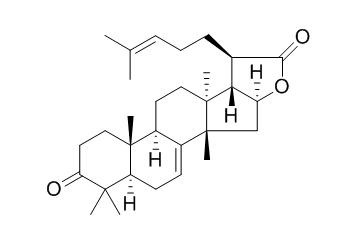Kulactone
Kulactone has cytotoxic effects, with IC₅₀ values of 5.6-21.2 ug/mL, it inhibited (ED(50) 2.5-6.2 microg/mL) the P388 cancer cell line.
Inquire / Order:
manager@chemfaces.com
Technical Inquiries:
service@chemfaces.com
Tel:
+86-27-84237783
Fax:
+86-27-84254680
Address:
1 Building, No. 83, CheCheng Rd., Wuhan Economic and Technological Development Zone, Wuhan, Hubei 430056, PRC
Providing storage is as stated on the product vial and the vial is kept tightly sealed, the product can be stored for up to
24 months(2-8C).
Wherever possible, you should prepare and use solutions on the same day. However, if you need to make up stock solutions in advance, we recommend that you store the solution as aliquots in tightly sealed vials at -20C. Generally, these will be useable for up to two weeks. Before use, and prior to opening the vial we recommend that you allow your product to equilibrate to room temperature for at least 1 hour.
Need more advice on solubility, usage and handling? Please email to: service@chemfaces.com
The packaging of the product may have turned upside down during transportation, resulting in the natural compounds adhering to the neck or cap of the vial. take the vial out of its packaging and gently shake to let the compounds fall to the bottom of the vial. for liquid products, centrifuge at 200-500 RPM to gather the liquid at the bottom of the vial. try to avoid loss or contamination during handling.
J AOAC Int.2023, 106(1):56-64.
Evid Based Complement Alternat Med.2017, 2017:9764843
Food Science and Biotechnology2015, 2205-2212
Evid Based Complement Alternat Med.2018, 2018:4580627
J. Korean Wood Sci. Technol.2022, 50(5):338-352.
J Pharm Biomed Anal.2018, 151:32-41
Kasetsart University2022, ethesis.1144.
J of Essential Oil Research2019, 1677272
Evid Based Complement Alternat Med.2020, 2020:1970349.
Appl. Sci.2021, 11(24),12080
Related and Featured Products
Nat Prod Res. 2016 Sep;30(17):1984-7.
Antimicrobial compounds from root, stem bark and seeds of Melia volkensii.[Pubmed:
26517430]
Three compounds, toosendanin (1), Kulactone (2) and scopoletin (3), were isolated from either the root bark and/or the stem bark of Melia volkensii. Their structures were determined on the basis of spectroscopic data generated and by comparison with data from the literature.
METHODS AND RESULTS:
1 and 2, isolated for the first time from M. volkensii, exhibited significant (p < 0.05) activity against Escherichia coli with minimum inhibitory concentration of 12.5 μg/mL, close to that of neomycin (6.25 μg/mL). The compounds also exhibited high activity against Aspergillus niger (MIC 6.25 μg/mL compared to 2.5 μg/mL for clotrimazole). Dichloromethane and methanol seed, hexane stem bark and methanol root bark extracts exhibited activities towards Escherichia coli, Staphylococcus aureus, Aspergillus niger and Plasmodium falciparum, respectively.
CONCLUSIONS:
Antimicrobial activity of the plant towards A. niger, P. falciparum and S. aureus is reported for the first time in the current work.
J Nat Prod. 2002 Dec;65(12):1886-91.
Antineoplastic agents. 489. Isolation and structures of meliastatins 1-5 and related euphane triterpenes from the tree Melia dubia.[Pubmed:
12502333 ]
METHODS AND RESULTS:
The bark of the giant neem tree Melia dubia was found to contain 11 euphane-type triterpenes. Five new compounds, meliastatins 1-5 (1-5), proved to inhibit growth of the P388 lymphocytic leukemia cell line (ED(50) 1.7-5.6 microg/mL). Four of the others, the previously known methyl kulonate (8), kulinone (9), 16-hydroxybutyrospermol (10), and Kulactone (11), were also found to inhibit (ED(50) 2.5-6.2 microg/mL) the P388 cancer cell line. In addition, two new euphane triterpenes were isolated and named dubione A (6) and dubione B (7).
CONCLUSIONS:
Structures for each of the 11 euphane triterpenes were established by spectral techniques that included HRMS and 2D NMR.



